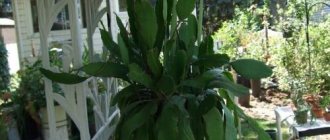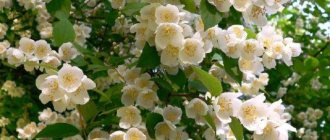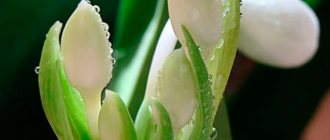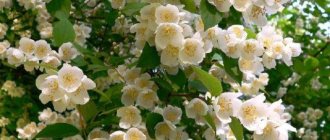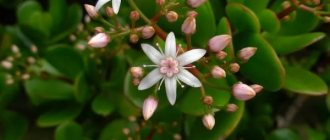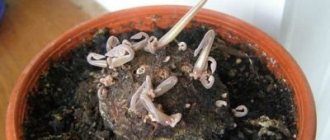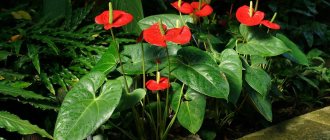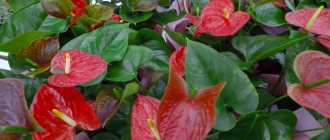Author: Elena N. https://floristics.info/ru/index.php?option=com_contact&view=contact&id=19 Category: Houseplants Published: February 17, 2019Last edits: January 11, 2021
- Growing from seeds
- The gardenia's buds are falling off
Gardenia is one of the most beautiful flowering plants in indoor culture. And, perhaps, one of the most capricious. Gardenia has won love and recognition in many countries. For the Japanese it symbolizes secret passion, for the Chinese it symbolizes femininity, grace and aristocratic fragility. Lovers of indoor plants are delighted by the beauty of gardenia flowers and leaves and its delicate, pleasant aroma. However, caring for this plant is not easy.
- How to plant and replant gardenia?
- What conditions does it need for normal development and abundant flowering?
- What kind of care will she need?
You will learn about this and much more from our article.
Planting and caring for gardenia
- Flowering: from July to October.
- Lighting: bright diffused light (placed on eastern and western window sills, shading will be required on southern windows in the afternoon).
- Temperature: from 16 to 24 ˚C.
- Watering: during the period of active growth - as the top layer of soil dries, in winter - with a delay of 2-3 days.
- Humidity: high, especially during budding.
- Feeding: young gardenias - 2 times a month alternately with mineral and organic fertilizers in liquid form, adults - every week, but the fertilizers should not contain calcium.
- Dormant period: February-March.
- Transplantation: in early spring or after flowering: young gardenias are replanted annually, adults - once every 3 years.
- Reproduction: seed and vegetative (cuttings).
- Pests: white aphids, spider mites, scale insects, mealybugs and thrips.
- Diseases: sooty fungus, chlorosis.
Read more about growing gardenia below.
Gardenia (lat. Gardenia) is a genus of the Rubiaceae family from the tropics, which is named after the American physician and naturalist Alexander Garden. In indoor conditions, the gardenia flower does not take up much space, but in nature - in East and Southeast Asia, as well as in South Africa - the gardenia plant sometimes reaches two meters in height. Gardenia, grown at home - jasmine, sometimes called "Japanese beauty" by gardeners; it came to England in 1760.
Flower growers grow it not only for the beautiful white, waxy flowers that emit a subtle jasmine scent, but also for the glossy leaves of a rich dark green color, which are a worthy decoration for gardenia when it is not in bloom.
- How to grow cucumbers on a windowsill - not every variety is suitable, but care is not particularly difficult
The necessary conditions
For the appearance of buds, it is important to create the right and comfortable conditions:
- Room temperature within +23-25°C.
- Be sure to avoid sudden changes and drafts.
- It is necessary to have humid air in the room, approximately 50-70%.
- To maintain the specified humidity parameters, it is worth spraying the foliage daily.
- You also cannot do without intense lighting. Gardenia loves sunlight, but during hot periods you need to be careful with it.
- In addition to lighting, watering is also important. The soil should not dry out completely; the plant prefers a moist growing environment.
- Be sure to feed the gardenia before and after flowering. The best option is mineral fertilizers with the main components phosphorus and potassium.
- Use fertilizers 3-4 times a month.
- Spray the flower with iron-containing preparations.
Features of cultivation
Gardenia jasminoides is an evergreen bush that grows in a room up to 45-50 cm in height. Its shoots are sometimes bare, sometimes pubescent; the leaves are dark green, bright, shiny, as if opened with varnish, short-petiolate, about 10 cm in length, broadly lanceolate or obovate, entire, tapering towards the base. Gardenia blooms in summer with fragrant single or few-flowered (4-6 pieces) corymbose inflorescences, axillary or apical. At the beginning of flowering, the flowers are boiling white, but gradually turn yellow. The diameter of the flowers reaches 8 cm, and varieties with double flowers are most often grown in cultivation. Caring for gardenia at home is not as simple as, for example, pelargonium, but the result is worth the effort.
So, what are the features of home gardenia:
- gardenia does not tolerate dry soil or stagnant water;
- gardenia is very demanding on air humidity, so be prepared for frequent daily spraying;
- For gardenia, soil acidity is of great importance, so conduct a soil test for this indicator before planting the plant and ensure that the pH is no more than 5.5;
- the air temperature should not be higher than 24 ºC and lower than 16 ºC if you are interested in the quality of gardenia flowering;
- Remove spent buds immediately.
How can I recognize you, gardenia jasmine?
At home, an adult bush can grow from 50 to 180 cm in height. It has strong woody shoots with shiny leaves and large fragrant flowers. Gardenia photo blooms in nature twice a year. Large-flowered forms with a long flowering period have been developed in culture.
However, growing and waiting for the capricious beauty to bloom is not easy. It is difficult to create the desired microclimate and maintain it unchanged at home. Gardenia jasmine responds to the slightest deviation in care by changing the color of the leaves, freezing, dropping flowers and cover. Read about coin loosestrife!
Even prolonged bad weather can spoil the mood of a tropical guest. Lack of light causes the plant to freeze. It is important to provide lighting for your sissy to relieve stress. Moreover, now there are special additional illumination lamps. The plant cannot tolerate:
- prolonged exposure to direct midday sunlight;
- dry air;
- improper watering and nutrition;
- uncomfortable temperature.
Flowering occurs at the tips of the shoots and axillary, closer to the light. Therefore, annual pruning of lignified branches allows you to make the bush decorative and provides planting material for propagation - cuttings.
In the caring hands of a skilled housewife, jasmine gardenia, photo, will delight you with its radiant appearance and exquisite aroma of flowers. The aroma is strong and there is no place for a flower in the bedroom.
When caring for a plant, you need to know that all parts of the flower are poisonous and you should work with protective gloves.
Caring for your home gardenia
Rules of care
Find a bright, warm place in the apartment, protected from drafts, for the gardenia - the lighting should be bright, but diffused; the temperature was mentioned above - from 16 to 24 degrees. Eastern or western window sills are most suitable for the flower; northern ones are excluded, and placement on a southern window sill will require shading from the sun's rays from 11:00 to 17:00.
In winter, you will have to supplement the gardenia with fluorescent lamps, since the winter daylight hours are too short for it. But even if the place for the gardenia is chosen well and you care for it correctly, it can take a very long time to settle down, get used to it, become capricious and even drop its buds.
Watering
One of the most important points in how to care for gardenia at home is watering the plant. Gardenia requires frequent watering, especially during the period of active growth - in spring and summer, as the top layer of soil dries. In autumn and winter, water less abundantly and often, waiting until 2-3 days have passed since the evaporation of moisture from the soil surface. Once a month, water the gardenia with acidified water, and the rest of the time, water it with soft water - boiled or filtered. And be sure to be warm: the temperature of the soil in the pot should be the same as the air in the room.
Air humidity, especially during budding, should be high, so place the flower in a tray with damp moss, expanded clay or pebbles, but in such a way that the bottom of the pot does not touch the water. Spray frequently with warm water, but only until the buds begin to open: when water gets on the flower, brown spots form on it. Instead of spraying, wipe the gardenia leaves with a damp sponge. Do not move or turn the flowerpot, otherwise the plant will drop its buds in a panic.
Fertilizer
Young gardenias need to be fed twice a month with mineral and organic fertilizers alternately. For an adult plant - weekly throughout the growing season, excluding fertilizers containing calcium. It is preferable to use a liquid form of mineral fertilizers (Vito, for example) in accordance with the attached instructions.
- Indoor plants after summer - what to do before returning to the house?
Gardenia benefits from peat-humic fertilizer; liquid potassium fertilizer for flowering indoor plants does not cause any complaints, but the dose must be halved than recommended by manufacturers. To normalize the pH, iron-containing preparations are added twice during the growing season. In winter, gardenia does not need fertilizing.
Transfer
The soil for gardenia should consist of equal parts of sand, turf, coniferous, peat and leaf soil. A decent drainage layer is required. We have already talked about acidity. If for some reason you cannot make the soil mixture yourself, buy soil for azaleas at the store. Gardenias are replanted in early spring or after flowering, and only if absolutely necessary. For young plants, this need exists once a year, for adults – once every three years. If you do everything right.
It is not advisable to replant a newly purchased gardenia right away; wait a couple of weeks. If you bought the plant in bloom, wait until the flowering process is complete before replanting the gardenia. In order not to cause unnecessary inconvenience to the capricious flower, transfer it to a new pot with drainage and add the required amount of soil to the pot.
Why doesn't it bloom?
Let's find out why gardenia doesn't bloom for a long time or at all, what to do and how to deal with it correctly.
The reasons for the lack of flowering of this tropical beauty may be the following factors:
- lack of soil acidity;
- hard water when watering;
- temperature changes;
- lack of lighting;
- dry air;
- mineral deficiency (or excess).
So what to do if the bush does not bloom?
- It is necessary to provide the flower with optimal living conditions for it .
It is important that the pot is fully illuminated all the time, except at night. At the same time, in summer the flower must be shaded from direct sun, and in winter, on the contrary, placed on the sunniest windowsill in the apartment. If the apartment is located on the north side of the house, and there are no sunny window sills, the bush will need additional lighting. To create an artificial “sun”, use ordinary fluorescent lamps located at a distance of 60-70 cm from the pot. - The plant needs constantly moist air and soil. At the same time, neither excessive waterlogging nor drying out should be allowed. Regular watering is necessary - use only soft, settled water, slightly acidified with lemon juice. In summer, watering should be more abundant, in winter - less frequent.
Note! To ensure constant air humidity, place the gardenia pot on a tray with expanded clay or sphagnum moss.Spraying should be carried out regularly. But during the period when the buds are blooming, spraying should be stopped to avoid the appearance of spots on the delicate petals.
Temperature is also important for flowering. The plant feels best in winter at +18-22 degrees, and in summer at +22-24 degrees.
The temperature in the room should not drop below +16 degrees - the tropical beauty does not tolerate cold weather. Exceeding any of these limits will result in a lack of (temporary or permanent) flowering. Moreover, if the shrub is placed in a room with an air temperature that is too low for it, the buds will not open at all.Also make sure that the soil temperature matches the air temperature - there should be no difference between these two values.
- To stimulate the plant to bloom for a long time, you can pamper it with a “steam bath” . To do this, bring the pot into the bathroom, fill the bathtub with hot water to the brim, and leave the gardenia in this humid, warm atmosphere for 2-3 hours. Until the buds bloom, you can repeat the procedure every week.
Gardenia propagation
Growing from seeds
Growing gardenia from seeds is not the best way to propagate the plant. Only freshly collected seeds are suitable for propagation, since they quickly lose their viability. Before planting in soil for azaleas, the seeds must be soaked for 2-3 hours in Zircon or aloe juice - stimulants, then sow the seeds on the soil and sprinkle the same mixture on top through a sieve with a layer of 0.5 cm, carefully water, cover the container with the seeds with film or glass and keep warm, ventilating from time to time for 1-2 hours. Shoots will appear no earlier than in a month. If seedlings appear in autumn-winter, they will have to be artificially supplemented with light.
Gardenia cuttings
When the gardenia has finished blooming, it is usually cut back to two-thirds the length of the shoots, removing weak shoots and thinning if the bush has become too dense. During the growth period, from time to time you also have to pinch one shoot or another, stimulating tillering. These cuttings are the material for propagating gardenia - apical and semi-lignified. The length of the shoot should be about 10 cm. The substrate for cuttings is a 1:1 mixture of river sand and peat. Keep the cuttings in a pale pink solution of potassium permanganate for half an hour, plant them in the ground and cover with glass or film to ensure a greenhouse effect.
The temperature should be 25 ºC, it is necessary to regularly ventilate the cuttings and moisten the soil. You can speed up root formation by arranging bottom heating for the cuttings. Once the cuttings have taken root, they are transplanted into azalea or mature gardenia potting soil, and when they reach a height of 15 cm, they are pinched to encourage the appearance of side shoots. When the side shoots grow 10-12 cm in height, they are also pinched. When the young gardenia becomes a bush, it is transferred to a larger pot.
Gardenia jasmine leaves turn yellow
An indicator of the health of a houseplant is the condition of the leaves. If gardenia leaves turn yellow, you need to urgently look for the cause:
- Yellowing of the lower tier of leaves indicates whether the humidity balance is off or the plant is in a draft. It is necessary to reduce watering and remove the tray with pebbles.
- Yellowness of the upper leaves indicates a lack of nitrogen or its poor absorption. This is also a sign of watering with hard water, as a result of which the acidity of the soil is disturbed.
- When there is insufficient light, gardenia jasmine turns yellow and sheds its buds and leaves. The plant lacks iron in chelated form or nitrogen. You just need to restore the balance gradually, otherwise the effect will be the opposite.
The cause of yellowing may be the colonization of leaves by spider mites. Any deviation in the content of gardenia leads to a stop in flowering and the dropping of buds.
Diseases and their treatment
The gardenia's buds are falling off
Sometimes this problem begins at the moment of bud formation: the temperature regime has been disturbed. Strictly ensure that the temperature stays between 20-18 ºC during the day and 18-16 ºC at night. If the temperature is too high at night, buds may not form at all. And no sudden changes! Watering gardenias should be regular. Insufficient air humidity or improper lighting, drafts, moving a flowerpot with a flower from place to place - any violation of the rules for caring for gardenia can lead to the plant losing buds. Therefore, be vigilant and disciplined.
- What conditions do violets need to bloom?
Gardenia turns black
The simplest explanation for why gardenia leaves turn black is that it is not watered correctly. Either the soil is too dry, or it has been too wet for a long time - this is why the leaves of the gardenia turn black and fall off. Pere
When and how long does flowering last?
Under favorable conditions, gardenia blooms in early spring, and the phenomenon continues until autumn. Or rather, from March to September, for six months. But it happens that the period is reduced due to poor quality care. Even the slightest mistake can lead to the buds dropping.
I would also like to note that the flowers do not bloom all at once, but one by one. Therefore, the green bush has several snow-white buds that take 2 months to ripen. And the blooming flower stays on the gardenia for about 4 days. Faded inflorescences must be cut off immediately to form new ones.
Transfer
As a rule, gardenia is sold as a whole bush, so it requires replanting for normal development.
In order to avoid damage to the root system of the flower, which can often be very tangled roots, for transplantation purposes it is best to use the transshipment method, transporting it along with an earthen clod. The procedure should be carried out regularly, every year, after flowering has ended.
Transplant methods
For adult plants, replanting once every three to four years will be sufficient.
Azaleas soil is suitable as soil for replanting gardenias. It can be purchased at flower shops or nurseries, or you can prepare it yourself.
Before transplanting, you need to place the plants in water heated at room temperature for one hour, which will allow you to separate the excess soil and untangle the roots.
Next, it is recommended to immerse the flower in a solution in which the growth stimulator “Kornevin” is diluted for two hours. During transshipment, the existing soil on the roots is left and new soil is poured into the pot. The lower part of the stem should enter the ground only 0.5-1 cm in order to avoid death from sudden rotting.
The most famous plant species and varieties
In the home environment, gardenia jasmine or, more correctly, jasminoides, has taken root best. It is distinguished by high decorative qualities. She is extremely thermophilic. In hot countries it is grown in gardens, in areas with a cool climate - in rooms or greenhouses.
Currently, a large number of different varieties of this species are known:
- Beauty is one of the most common; it can be distinguished by its large double white flowers;
- Amy - its foliage is dark in color, and the perfect shape of large double flowers gives it the appearance of an artificial plant;
- Radicans is a compact bush, ideal for creating bonsai.
